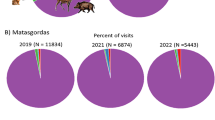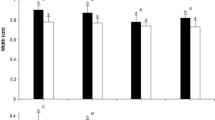Abstract
We examined the ecological relevance of bird versus mammal dispersal syndromes in four species of Solanum, S. americanum Type A, S. americanum Type B, S. ptychanthum, and S. sarrachoides. These plants were selected because their morphological characteristics, such as fruit color, mass, and persistence, resembled those typically associated with classically-defined bird and mammal dispersal syndromes. We monitored persistence of tagged fruits, compared physical and chemical chaacteristics, performed fruit preference trials with northern bobwhite quail (Colinus virginianus), deer mice (Peromyscus maniculatus), and American robins (Turdus migratorius), and assessed differences in use of olfactory cues by foraging deer mice. We predicted that principal components analysis of physical and chemical characteristics would place fruits of these species along a clear gradient from bird to mammal dispersal syndromes (S. americanum Type A, S. americanum Type B, S. ptychanthum, and S. sarrachoides). However, physical and chemical characteristics did not consistently follow the gradient. Also, contrary to expectations, both birds and mammals demonstrated a preference for S. americanum Types A and B, both “bird” fruits. Deer mice and bobwhite quail showed much less discrimination among fruit types than did American robins. While the relatively strong odor of the green-fruited S. sarrachoides suggested a mammalian attractant, deer mice discovered the relatively odorless S. americanum Type A significantly more quickly. We conclude that in Solanum, suites of morphological characteristics resembling bird and mammal dispersal syndromes are not good predictors of fruit choice by birds and mammals. We note, however, that this conclusion is based on a sample of three animal species. Alternative explanations for fruit character suites should be considered. For example, the adaptive significance for an association of green coloration of ripe fruit with impersistence (dropping when ripe), as in S. sarrachoides and some S. ptychanthum, may relate more to photosynthesis and carbon balance in detached fruits than to disperser attraction.
Similar content being viewed by others
References
Abacus Concepts (1989) SuperANOVA: accessible general linear modeling. Abacus Concepts, Berkeley, California
Abacus Concepts (1992) StatView. Abacus Concepts, Berkeley, California
Birner J (1969) Determination of total steroid bases in Solanum species. J Pharm Sci 58: 258–259
Boland FE (1984) Fruits and fruit products. In: Williams S (ed) Official methods of analysis of the A.O.A.C., 14th edn. Association of Official Analytical Chemists, Arlington, Virginia, pp 413–428
Cipollini ML, Levey DL (1991) Why some fruits are green when they are ripe: carbon balance in fleshy fruits. Oecologia 88: 371–377
Cipollini ML, Stiles EW (1992) Relative risks of microbial rot for fleshy fruits: significance with respect to dispersal and selection for secondary defense. Adv Ecol Res 23: 35–91
Cipollini ML, Stiles EW (1993) Fruit rot, antifungal defense, and palatability of fleshy fruits for frugivorous birds. Ecology 74: 751–762
Debussche M, Isenmann P (1989) Fleshy fruit characters and the choices of bird and mammal seed dispersers in a Mediterranean region. Oikos 56: 327–337
Denslow JS, Moermond TC, Levey DJ (1986) Spatial components of fruit display in understory trees and shrubs. In: Estrada A, Fleming TH (eds) Frugivores and seed dispersal. Junk, Dordrecht, pp 37–44
Denslow JS, Levey DJ, Moermond TC, Wentworth BC (1987) A synthetic diet for fruit-eating birds. Wilson Bull 99: 135–136
Fischer KE, Chapman CA (1993) Frugivores and fruit syndromes: differences in patterns at the genus and species level. Oikos 66: 472–482
Gautier-Hion A, Duplantier J-M, Quris R, Feer F, Sourd C, Decoux J-P, Dubost G, Emmons L, Erard C, Hecketsweiler P, Moungazi A, Roussilhon C, Thiollay J-M (1985) Fruit characters as a basis of fruit choice and seed dispersal in a tropical forest vertebrate community. Oecologia 65: 324–337
Howe HF (1986) Seed dispersal by fruit-eating birds and mammals. In: Murray DR (ed) Seed dispersal. Academic Press, New York, pp 123–189
Janson CH (1983) Adaptation of fruit morphology to dispersal agents in a neotropical forest. Science 219: 187–189
Janzen DH (1985) On ecological fitting. Oikos 45: 308–310
Janzen DH, Martin PS (1982) Neotropical anachronisms: the fruits the gomphotheres ate. Science 215: 19–27
Johnson RA, Willson MF, Thompson JN, Bertin RI (1985) Nutritional values of wild fruits and consumption by migrant frugivorous birds. Ecology 66: 819–827
Jones CB (1984) Plants. In: Williams S (ed) Official methods of analysis of the AOAC., 14th edn. Association of Official Analytical Chemists, Arlington, Virginia, pp 38–61
Jones CG, Hare JD, Compton SJ (1989) Measuring plant protein with the Bradford assay. 1. Evaluation and standard method. J Chem Ecol 15: 979–992
Keeler-Wolf T (1988) Fruit and consumer differences in three species of trees shared by Trinidad and Tobago. Biotropica 20: 38–48
Knight RS, Siegfried WR (1983) Inter-relationships between type, size and colour of fruits and dispersal in southern African trees. Oecologia 56: 405–412
Levey DJ (1986) Methods of seed processing by birds and seed deposition patterns. In: Estrada A, Fleming TH (eds) Frugivores and seed dispersal. Junk, Dordrecht, The Netherlands.
Levey DJ (1987) Sugar-tasting ability and fruit selection in tropical fruit-eating birds. Auk 104: 173–179
Levey DJ, Moermond TC, Denslow JS (1984) Fruit choice in Neotropical birds: the effect of distance between fruits on preference patterns. Ecology 65: 844–850
Martin AC, Zim HS, Nelson AL (1951) American wildlife and plants. McGraw-Hill, New York
McKey D (1973) The ecology of coevolved seed dispersal systems. In: Gilbert L, Raven P (eds) Coevolution of animals and plants. University of Texas Press, Austin, pp 159–191
McPherson JM (1988) Preferences of cedar waxwings in the laboratory for fruit species, colour and size: a comparison with field observations. Anim Behav 36: 961–969
Moermond TC, Denslow JS (1983) Fruit choice in Neotropical birds: effects of fruit type and accessibility on selectivity. J Anim Ecol 52: 407–420
Ogg AG Jr, Rogers BS, Schilling EE (1981) Characterization of black nightshade (Solanum nigrum) and related species in the United States. Weed Sci 29: 27–30
Palmeirim JM, Gorchov DL, Stoleson S (1989) Trophic structure of a neotropical frugivore community: is there competition between birds and bats. Oecologia 79: 403–411
Pijl Lvan der (1969) Principles of dispersal in higher plants. Springer, Berlin Heidelberg New York
Ripperger H, Schreiber K (1981) Solanum steroid alkaloids. In: Mankse RHF, Rodrigo RGA (eds) The alkaloids, vol XIX. Academic Press, New York, pp 81–192
SAS Institute (1988) SAS/STAT User's Guide, Release 6.03 Edition. SAS Institute, Cary, North Carolina
Schilling EE (1981) Systematics of Solanum sect. Solanum (Solanaceae) in North America. Syst Bot 6: 172–185
Schreiber K (1968) Steroid alkaloids. The Solanum group. In: Mankse RHF (ed) The alkaloids, vol X. Academic Press, New York, pp 1–192
Schupp EW (1992) Quantity, quality and the effectiveness of seed dispersal by animals. Vegetatio 107: 15–30
Smith D (1981) Removing and analyzing total nonstructural carbohydrates from plant tissue. (Wisconsin Agricultural Experimental Station Bulletin 2107). University of Wisconsin, Madison
Snow DW (1970) Evolutionary aspects of fruit-eating by birds. Vegetatio 113: 194–202
Spiro RG (1966) Analysis of sugars found in glycoproteins. In: Newfield EF, Ginsberg V (eds) Methods in enzymology, vol VIII. Academic Press, New York, pp 3–26
Stiles FG, Rosselli L (1992) Consumption of fruits of the Melastomataceae by birds: how diffuse is coevolution? Vegetatio 107: 57–74
Willson MF (1994) Fruit choices by captive American robins. Condor 96: 494–502
Willson MF, Comet TA (1993) Food choices by northwestern crows: experiments with captive, free-ranging, and hand-raised birds. Condor 95: 596–615
Willson MF, Whelan CJ (1990) The evolution of fruit color in fleshy-fruited plants. Am Nat 136: 790–809
Willson MF, Irvine AK, Walsh NG (1989) Vertebrate dispersal syndromes in some Australian and New Zealand plant communities, with geographic comparisons. Biotropica 21: 133–147
Willson MF, Graff DA, Whelan CJ (1990) Color preferences of frugivorous birds in relation to the colors of fleshy fruits. Condor 92: 545–555
Yemm EW, Willis AJ (1954) The estimation of carbohydrates in plant extracts by anthrone. Biochem J 57: 508–514
Author information
Authors and Affiliations
Rights and permissions
About this article
Cite this article
Tamboia, T., Cipollini, M.L. & Levey, D.J. An evaluation of vertebrate seed dispersal syndromes in four species of black nightshade (Solanum sect. Solanum). Oecologia 107, 522–532 (1996). https://doi.org/10.1007/BF00333944
Received:
Accepted:
Issue Date:
DOI: https://doi.org/10.1007/BF00333944




